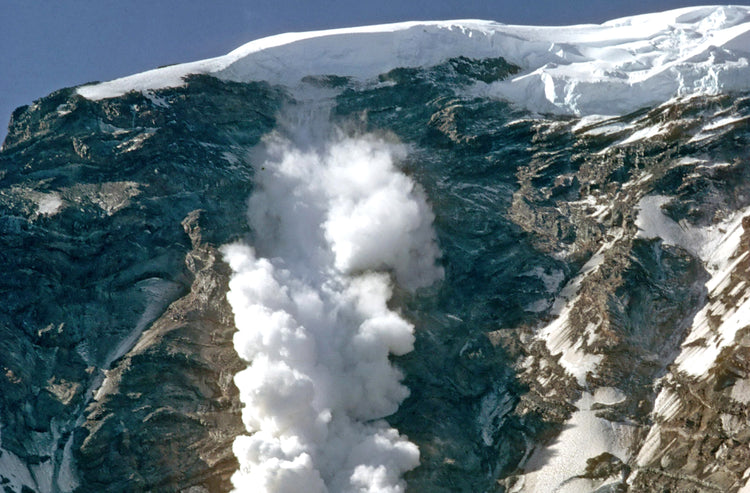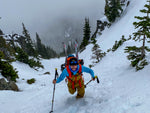Introduction
Avalanche awareness is a given for most winter mountain pursuits - backcountry skiers and split-boarders, snowshoers, and ski mountaineers all have Avy awareness top of mind when they're recreating. But as temps warm up and we swap skis for mountaineering boots, avalanche awareness can sometimes take a back seat, despite being a very real threat.
The Overlooked Hazard: Warm-Weather Avalanches
While most backcountry enthusiasts are well-versed in winter avalanche safety, armed with transceivers, probes, and shovels, the approach to navigating the avalanche risks of spring and summer mountaineering often lacks structure. Avalanche education predominantly focuses on winter conditions, leaving a gap in knowledge and preparedness for the unique challenges faced by mountaineers during the warmer months. As the snowpack recedes, it exposes additional dangers such as cliffs, crevasses, and terrain traps, rendering even minor avalanches potentially lethal.
Mountaineering in the spring and summer demands a keen awareness of evolving conditions. Snow instability, coupled with specific terrain features and triggers—often members of your own party—can spell disaster. Safety hinges not only on survival skills but also on the ability to steer clear of avalanches altogether.
Differences between Backcountry Skiing and Mountaineering Avalanche Problems
The strategies and hazards associated with mountaineering and backcountry skiing in avalanche-prone areas diverge significantly. Mountaineers traverse a diverse array of terrains, encountering risks from intricate environments like glaciers and crevasses. Their preparation must encompass a spectrum of environmental hazards and include proficiency with technical climbing and navigation gear. In contrast, skiers primarily contend with snow-covered slopes, prioritizing avalanche-specific knowledge, including forecast interpretation and rescue techniques.
Types of Avalanches
While mountaineers can absolutely experience storms that create new-snow avalanche hazards, the majority of the problems you'll face on glaciated terrain in the spring and summer months are caused by strong winds and intense UV radiation. These factors are key in creating the below common avalanche problems.
Loose Snow Avalanches
Commonly known as sluffs, these slides start from a single point and spread out, gathering momentum as they descend. Whether dry or wet, these avalanches pose a significant risk to climbers, particularly in challenging terrain. In spring and summer, the intense UV radiation can make wet loose avalanches relatively predictable. Avoiding these slides necessitates careful route planning to steer clear of slopes prone to warming, especially during ascent or descent.
Cornice Falls
Climbers traversing snow ridges or ascending snowy summits must be wary of cornices, which can collapse and trigger slab avalanches below. Steer clear of these features, especially during periods of freezing and thawing.
Icefall Avalanches
Sections of seracs or ice cliffs failing on steep glaciers can lead to icefall avalanches, presenting falling ice hazards. To mitigate risks, minimize time spent in areas prone to icefall and avoid camping in locations exposed to collapsing ice, especially as temperatures warm throughout the day.
Slab Avalanches
Formed when cohesive snow rests on a weak layer, slab avalanches can fracture and slide if this layer fails. Spring and summer conditions can exacerbate these hazards, with added moisture making them denser and more challenging to trigger. It's crucial to recognize warning signs in weather forecasts to avoid these potentially dangerous occurrences.
Recognizing Terrain Hazards
The Avalanche Terrain Exposure Scale (ATES) is used to classify avalanche terrain into one of five distinct categories. Most of the glaciacted terrain in North America falls into the Complex or Extreme categories, characterized by "very steep faces with cliffs, spines, couloirs, crevasses, or sustained overhead hazard." In terrain like this, there is often no option to reduce exposure, and small avalanches can be fatal due to complex runouts. This is why sluff that might not be on your radar when you're skiing powder should absolutely be a concern when you're traversing a glaciated slope.
Climbing Safely in Avalanche Terrain
Ensure safe travel by selecting routes that minimize exposure to danger. Choose windward slopes, less steep slopes, edges of slopes, and avoid convex rollovers and gullies. Exercise caution on shaded slopes in winter and sunny slopes in spring. Avoid camping in valleys exposed to avalanche danger from above.
Crossing a Questionable Slope
Before traversing a questionable slope, prepare appropriately and maintain a vigilant stance. Follow safety protocols, such as heading straight up the fall line, traversing one person at a time, and crossing with long, smooth strides to minimize avalanche risk.
Before crossing the slope, consider if the risk of falling is greater than the risk of an avalanche, and only rope up if that is the case.
Importance of Proper Avalanche Education and Rescue Training
Comprehensive avalanche education covers hazard identification, rescue techniques, and decision-making skills. Hands-on rescue training, coupled with accredited avalanche courses, equips mountaineers with the knowledge and skills necessary to navigate avalanche safety effectively.
Even if you're not a winter sports enthusiast, and only climb in the spring and summer months, avalanche education is a crucial foundation of further mountaineering knowledge.
While many of the avalanche awareness foundations remain the same between winter and summer mountain recreation, it's important to pay attention to the increased risks of UV based avalanche problems during warmer months. Hopefully this post serves as a starting point for you to think more deeply about the avalanche problems you may encounter on your next climb!


